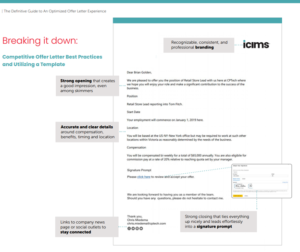- Solutions
- Products
- Community
- Resources
- Company
Create incredible candidate experiences that communicate your brand, mission, and values with recruitment marketing solutions.
Learn moreCommunicate effectively and efficiently with the candidates that can drive your business forward.
Learn moreSelect the right candidates to drive your business forward and simplify how you build winning, diverse teams.
Learn moreHelp your best internal talent connect to better opportunities and see new potential across your entire organization.
Learn moreCommunicate collectively with large groups of candidates and effectively tackle surges in hiring capacity.
Learn moreAccess tools that help your team create a more inclusive culture and propel your DEI program forward.
Learn moreRebound and respond to the new normal of retail with hiring systems that are agile enough to help you forge ahead.
Learn moreAccelerate the hiring of key talent to deliver point of care and support services that meet and exceed your promise of patient satisfaction.
Learn moreAttract and engage candidates with technical competencies, accelerate hiring for much-needed skills, and advance expertise within your valued workforce.
Learn moreSimplify how you recruit finance, insurance, and banking candidates with a unified platform built to match top talent with hard-to-fill roles.
Learn moreYour business strategy depends on your people strategy. Keep both in lockstep with the iCIMS Talent Cloud.
Learn moreBuild an engaging, high-converting talent pipeline that moves your business forward.
Learn moreDeliver the innovation your talent team needs, along with the global scale and security you demand.
Learn moreDeliver tailored technology experiences that delight users and power your talent transformation with the iCIMS Talent Cloud.
Learn moreThe #1 ATS in market share, our cloud-based recruiting software is built for both commercial and large, global employers.
Learn more Talk to salesAttract the best talent for your business with powerful, on-brand career websites that excite candidates and drive engagement.
Learn more Talk to salesBuild talent pipelines, engage candidates with multi-channel marketing campaigns, and use machine learning to automatically surface the right talent for the job.
Learn more Talk to salesEmpower candidates with automated self-service, qualification screening, and interview scheduling through an AI-enabled digital assistant.
Learn more Talk to salesSimplify employee onboarding with automated processes that maximize engagement and accelerate productivity.
Learn more Talk to salesCompliment your sourcing and engagement efforts with award-winning lead scoring and advanced campaign personalization.
Learn more Talk to salesImprove employee experience, retention, and reduce internal talent mobility friction with the iCIMS Opportunity Marketplace.
Learn more Talk to salesVerify skills with game-changing levels of automation and simplicity to improve the quality of hire at scale.
Learn more Talk to salesModernize, streamline, and accelerate your communication with candidates and employees.
Learn more Talk to salesTransform the talent experience by showcasing your authentic employer brand through employee-generated video testimonials.
Learn more Talk to salesGet robust analytics that help you make sense of your data and illuminate your talent pool.
Learn moreSimplify recruiting, dynamically engage talent, and reduce hiring bias with job matching and recruiting chatbot technology.
Learn more Talk to salesGet exclusive intel on industry and market trends along with expert one-on-one advice.
Learn more Talk to salesThe #1 ATS in market share, our cloud-based recruiting software is built for both commercial and large, global employers.
Learn more Talk to salesAttract the best talent for your business with powerful, on-brand career websites that excite candidates and drive engagement.
Learn more Talk to salesBuild talent pipelines, engage candidates with multi-channel marketing campaigns, and use machine learning to automatically surface the right talent for the job.
Learn more Talk to salesEmpower candidates with automated self-service, qualification screening, and interview scheduling through an AI-enabled digital assistant.
Learn more Talk to salesSimplify employee onboarding with automated processes that maximize engagement and accelerate productivity.
Learn more Talk to salesCompliment your sourcing and engagement efforts with award-winning lead scoring and advanced campaign personalization.
Learn more Talk to salesImprove employee experience, retention, and reduce internal talent mobility friction with the iCIMS Opportunity Marketplace.
Learn more Talk to salesVerify skills with game-changing levels of automation and simplicity to improve the quality of hire at scale.
Learn more Talk to salesModernize, streamline, and accelerate your communication with candidates and employees.
Learn more Talk to salesTransform the talent experience by showcasing your authentic employer brand through employee-generated video testimonials.
Learn more Talk to salesGet robust analytics that help you make sense of your data and illuminate your talent pool.
Learn moreSimplify recruiting, dynamically engage talent, and reduce hiring bias with job matching and recruiting chatbot technology.
Learn more Talk to salesGet exclusive intel on industry and market trends along with expert one-on-one advice.
Learn more Talk to salesHow a beloved restaurant hires 40,000+ annually with a great candidate experience.
Learn moreThousands strong, our global community of talent professionals includes creatives, innovators, visionaries, and experts.
Learn moreTogether we’re creating the world’s largest ecosystem of integrated recruiting technologies.
Learn moreExplore our network of more than 300 certified, trusted third-party service and advisory partners.
Learn moreUncover unique market insights, explore best practices and gain access to talent experts across out library of content.
Get resourcesExpert guidance about recruitment solutions, changes in the industry, and the future of talent.
Learn moreStay up to date with the latest terminology and verbiage in the HR software ecosystem.
Learn moreEmployers everywhere improve hiring efficiently and save money using iCIMS. Estimate the potential business value you can achieve.
Learn moreDive into the Class of 2023 Report highlighting this cohort’s expectations and where employers are willing — and able — to meet them.
Watch nowPartner with iCIMS to build the right strategies, processes, and experience to build a winning workforce.
Learn moreExpert guidance about recruitment solutions, changes in the industry, and the future of talent.
Learn moreThe iCIMS Talent Cloud delivers a secure, agile, and compliant platform designed to empower talent teams, job seekers, and partners with advanced data protection and privacy.
Learn moreView press releases, media coverage, and the latest hiring data. See what analysts are saying about iCIMS.
Learn moreiCIMS is the Talent Cloud company that empowers organizations to attract, engage, hire, and advance the talent that builds a winning workforce.
Learn moreGet to know the award-winning leadership team shaping the future of the recruiting software industry.
Learn moreWe believe the future of work isn't something that "happens" to you. It's something you create. We actively create the future of work with our customers every day.
Learn moreiCIMS is committed to being a responsible and ethical corporate citizen, which is why Environmental, Social and Governance (ESG) initiatives are strategic imperatives.
Learn moreStreamline your tech stack and take advantage of a better user experience and stronger data governance with ADP and the iCIMS Talent Cloud.
Learn moreThe combined power of iCIMS and Infor helps organizations strategically align their business and talent objectives.
Learn moreOur award-winning partnership with Microsoft is grounded in a shared desire to transform the workplace and the hiring team experience.
Learn moreOur partnership with Ultimate Kronos Group (UKG) supports the entire talent lifecycle by bringing frictionless recruiting solutions to UKG Pro Onboarding.
Learn moreLet’s get in touch. Reach out to learn more about iCIMS products and services.
Learn more

Even late in the recruiting process, lack of efficiency results in compliance risks, lack of professionalism, and increased time to hire. A poor offer experience leads to candidates withdrawing from the application process or accepting a competitor’s offer.
Losing candidates in the offer stage means it takes longer to fill roles. Unfilled positions hinder an organization’s ability to hit business goals.
Large, multi-division and global organizations have complex nuances to manage in the offer process. These nuances make it even more essential to identify pain points and risks. Here are just a few examples of what could cause complexity in an offer process:
To help you avoid risk and improve your offer letter process, we’re breaking down everything you need to know, starting with the importance of creating professional offer letters.
(Learn more about offer management software here.)
Before we get into what to include in an offer letter, we first need to understand why it’s important.
Suppose your competitor’s candidates receive offer letters that don’t quite look professional, contain mistakes, formatting issues, or lack branding. In that case, they may reconsider their decision to join the company.
Remember: A candidate can still back out at this stage.
You spend a lot of resources looking for the right candidate, interviewing them, and negotiating terms. A CEB survey of 900 recruiters and 6,000 hiring managers found that the average time to fill for employers increased by 50% from 2010. They found that the average vacancy costs $500 per position per day, a loss of $22,000 per position over the average period of 44 calendar days.
Along with the investment of time, recruiting expenses are increasing substantially too. “The biggest talent spending area around the world today is recruiting,” said Josh Bersin, founder of Bersin by Deloitte. “While companies spend around $1,200 a year per employee on employee training (making it an approximately $140 billion market), recruiting spend is about three times larger.”
Now that we know why professionalism is essential to your strategy and execution. Let’s dig into what an offer letter contains.
Formal offer letters provide an opportunity to solidify expectations and explain critical details of the position, salary, and benefits offered. Essential terms of employment to include in an offer letter are job details, compensation, and benefits. You’ll also want to ensure you’re pulling accurate data into fields such as:
A quick tip: Ensure that your letters have consistent fonts, proper spacing between paragraphs, the correct logo, and an eSignature.
Necessary information, like that noted above, is essential to creating an accurate offer letter. But so are blanket statements that will make the legal department your new cheerleader.
Here are two you’re going to want to look into:
1. A statement of at-will employment
Make sure you have a statement of “at-will employment.” While it may sound daunting, all this statement says is that the company or the employee can terminate the relationship at any time.
Not only should you state this in your offer letters, but you should avoid any language that implies a fixed period of employment.
Quick tips:
2. Applicable contingencies you need to know
To provide clarity and align employee-employer expectations, include information regarding whether employment is contingent upon certain conditions such as:
It’s essential to do your research on any applicable employment laws for your state and industry, as this might affect the language you include in your offer letter. For example, California and New York require an additional wage notice to non-exempt employees.
Here is a competitive offer letter template from our Definitive guide to an optimized offer letter experience:


The process to create and manage the offer template is equally as important as the letter itself. Lack of version control, rules, and lack of visibility unnecessarily complicate the process. In the next section, I’ll break down how manual or disjointed processes lead to compliance risks.
Today, many companies handle their offer letter process using multiple systems and tools or manage everything manually, which is often time-consuming and challenging for recruiters.
A manual or disjointed process can also easily lead to errors like using a template but forgetting to update necessary details like the candidate’s name and salary.
Beyond the inefficiencies lies compliance risks. Compliance risks are an even more significant concern for large organizations that hire nationally or globally. They often have hundreds of different offer letter templates and clauses for new hires. Without a streamlined process, they risk sending the wrong template or clause to the wrong candidate.
It isn’t easy to lock down without a centralized process that can see varying information levels. A truly centralized process typically involves 3-5 tools between recruitment software, email, Microsoft Word, and sometimes Excel. Without the right system in place, it’s challenging to manage the user permissions for individuals within the company, leaving your candidates’ data vulnerable.
Speaking of data, consider the following to keep everything safe:
Your candidates will appreciate the streamlined, accurate offer letter and process that gets them in the door faster. When you think about it, it’s all about extending the candidate experience.
Suppose your company’s current offer letter process needs work. You’re going to want to revamp the whole experience, starting with your candidates’.
Today, it’s more imperative than ever to make the entire hiring process as positive and easy an experience as possible.
Seal the deal and improve speed to hire through a streamlined offer letter process.
After all the work you’ve put into sourcing and building a positive relationship with a candidate, you don’t want to lose them at the offer stage. You should feel confident in delivering an accurate and professional offer letter to seal the deal with your best candidates.
Recruiters who use manual processes face frustrations when offer letters contain errors, are sent to the wrong candidates, embody different formats, and require physical signatures. Maintaining a professional employment brand through an offer letter process will enhance your recruiting efforts and enable you to hire best-fit talent quickly. Determining your company’s speed to hire can help improve your hiring process, ensuring that applicants have a great candidate experience.
Speed to hire measures the time it takes for a company‘s best candidate to transition from an applicant to a new hire. Essentially, speed to hire tracks how quickly a company spots its best candidate and moves them along the job pipeline, leading them to accept the final job offer.
To calculate speed to hire, subtract the day that an applicant enters the pipeline from the day the candidate accepts the job offer.
Lacking efficiency during the offer letter process makes recruiting much more complex, challenging, and time-consuming. After you complete the verbal offer, a manual offer letter process usually begins with outdated templates. It relies on printers and scanners to officiate offers. These methods typically result in errors and elongate the recruiting process altogether.
Slow offer letters extend the length of the entire recruiting process.
After all the work you’ve put into sourcing and building a positive relationship with a candidate, you don’t want to lose them at the offer stage. The spread of negative reviews about a company‘s lengthy recruiting process travels quickly and deters others from applying to any job position.
The offer letter process is an essential part of a company‘s candidate experience and could negatively impact its ability to hire the best applicants if not speedy. Professional letter formats comprise consistent, repeatable templates and are a company’s last chance to distinguish itself from competitors during the final stage of the recruiting process.
Want to learn more about the offer letter process? Check out The Definitive Guide to An Optimized Offer Letter Experience.
Reviewed for accuracy on March 10, 2021, by Alex Oliver.
and receive free tips on how to attract, engage, hire, & advance the best talent.





